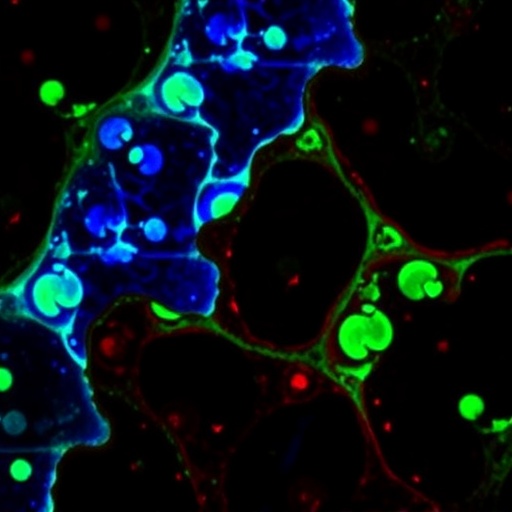In the relentless pursuit to unravel the molecular intricacies driving hepatocellular carcinoma (HCC), a devastating form of liver cancer marked by rapid progression and metastasis, scientists have homed in on a pivotal molecular axis involving SLIT2 and non-muscle myosin IIA (NMIIA). Recent research published in BMC Cancer elucidates how the bidirectional regulation between these two molecules orchestrates critical cellular processes such as mitophagy and epithelial-mesenchymal transition (EMT), thereby modulating tumor dynamics and opening promising avenues for therapeutic intervention.
Hepatocellular carcinoma represents a formidable challenge in oncology due to its complex molecular landscape and poor prognosis. The study centers around SLIT2, a guidance cue protein traditionally implicated in axonal pathfinding within neural development, and NMIIA, a key component of the cytoskeletal machinery responsible for generating contractile forces within cells. Intriguingly, the relationship between SLIT2 and NMIIA emerges as a decisive factor influencing HCC progression, with SLIT2 acting as a suppressor and NMIIA facilitating oncogenic behaviors.
Using a combination of sophisticated molecular techniques, including immunofluorescence and quantitative polymerase chain reaction (qPCR), the researchers meticulously analyzed human HCC tissue samples. The data revealed a stark downregulation of SLIT2 expression juxtaposed with an upregulation of NMIIA in tumor tissues relative to normal liver samples. This inverse relationship hints at a possible antagonistic regulatory axis, pivotal to tumor behavior and patient outcome.
Corroborating these findings with insights gleaned from the expansive The Cancer Genome Atlas (TCGA) repository, SLIT2 expression was found to inversely correlate with both tumor stage and metastatic potential. This robust association not only strengthens the evidence for SLIT2 as a tumor suppressor but also highlights its potential utility as a prognostic biomarker in clinical settings.
Delving deeper into cellular function, the study employed overexpression models to delineate the roles of SLIT2 and NMIIA in HCC cell dynamics. SLIT2 overexpression yielded a marked reduction in cellular proliferation, migration, and invasive capabilities. This suggests that reinstating SLIT2 activity could counteract tumor progression. Conversely, enforced NMIIA expression exacerbated these oncogenic phenotypes, amplifying the aggressiveness of the cancer cells.
At the mechanistic level, NMIIA was found to modulate two interconnected cellular phenomena: EMT and mitophagy. EMT is a biological process where epithelial cells acquire mesenchymal properties, enhancing motility and invasiveness, fundamental steps in metastatic dissemination. Mitophagy, a selective autophagic degradation of mitochondria, serves as a quality control mechanism but, when dysregulated, may support cancer cell survival under metabolic stress.
The study uncovered that NMIIA facilitates EMT by promoting the phosphorylation of the myosin regulatory light chain (MRLC), thereby enhancing cellular contractility and motility. Additionally, NMIIA-driven mitophagy supports tumor cells by maintaining mitochondrial integrity and metabolic adaptation, further contributing to malignancy.
Intriguingly, SLIT2 overexpression disrupts this oncogenic cascade by inhibiting MRLC phosphorylation, effectively dampening NMIIA activity. This suppression leads to a reversal of EMT markers and a decrease in mitophagic activity, collectively impairing the tumor’s ability to progress and metastasize.
The interplay extends to cellular adhesion properties; while NMIIA enhances adhesion and colony-forming potential—traits essential for tumor establishment and expansion—SLIT2 diminishes these adhesive interactions. Such modulation of cell-matrix dynamics underscores the multifaceted influence of the SLIT2/NMIIA axis in tumor biology.
The translational relevance of these findings was further substantiated by in vivo experiments. Xenograft models with SLIT2 knockdown exhibited accelerated tumor growth, emphasizing the protective role of SLIT2 in restraining HCC development. These animal studies bolster the conceptual framework positioning SLIT2 as a critical tumor suppressor and the NMIIA pathway as a driver of malignancy.
This groundbreaking research not only underscores the profound impact of cytoskeletal and mitophagic regulation in cancer progression but also highlights the SLIT2/NMIIA axis as a novel therapeutic target. By restoring SLIT2 function or inhibiting NMIIA activity, future therapies could disrupt the malignant cellular circuitry, potentially curbing tumor growth and metastasis.
Given the intricate, dualistic nature of these molecular players, precision medicine approaches tailored to modulate the SLIT2/NMIIA axis could revolutionize HCC treatment paradigms. Furthermore, the study stimulates compelling questions regarding whether similar mechanisms operate in other cancer types, suggesting broader implications for oncology.
The findings spotlight the critical role of fine-tuned cytoskeletal dynamics and mitochondrial quality control in cancer biology. As NMIIA emerges as an enabler of metastatic traits through EMT and mitophagy, therapeutic strategies targeting this protein could halt the insidious spread of HCC.
Moreover, the discovery that SLIT2 undermines these aggressive traits aligns with its function as a molecular brake, offering hope that enhancing its expression or mimicking its activity could restore cellular homeostasis and stall cancer advancement.
This research exemplifies the power of integrating molecular biology with clinical data repositories like TCGA, allowing for the robust validation of laboratory findings within human disease contexts. Such interdisciplinarity accelerates the translation of bench discoveries into bedside applications.
Looking ahead, the challenge lies in developing pharmacological agents capable of modulating the SLIT2/NMIIA axis with specificity and efficacy. The complexity of intracellular signaling networks demands innovative drug design and delivery strategies.
Understanding the mechanistic intricacies governing mitophagy modulation by NMIIA further enriches the landscape of metabolic interventions in cancer, linking cytoskeletal function with organelle homeostasis and survival pathways.
In summary, this seminal work charts new territory in HCC research, identifying a crucial regulatory axis that orchestrates tumor behavior through cytoskeletal and mitochondrial pathways. The SLIT2/NMIIA axis stands out as a beacon for novel therapeutic development, potentially transforming outcomes for patients afflicted by this formidable cancer.
Subject of Research: Molecular mechanisms regulating hepatocellular carcinoma progression through the SLIT2/NMIIA axis, impacting mitophagy and epithelial-mesenchymal transition.
Article Title: SLIT2 modulates NMIIA to regulate mitophagy and suppress hepatocellular carcinoma progression.
Article References:
Qin, Y., Zhou, J., Li, S. et al. SLIT2 modulates NMIIA to regulate mitophagy and suppress hepatocellular carcinoma progression. BMC Cancer 25, 1561 (2025). https://doi.org/10.1186/s12885-025-14951-x
Image Credits: Scienmag.com




